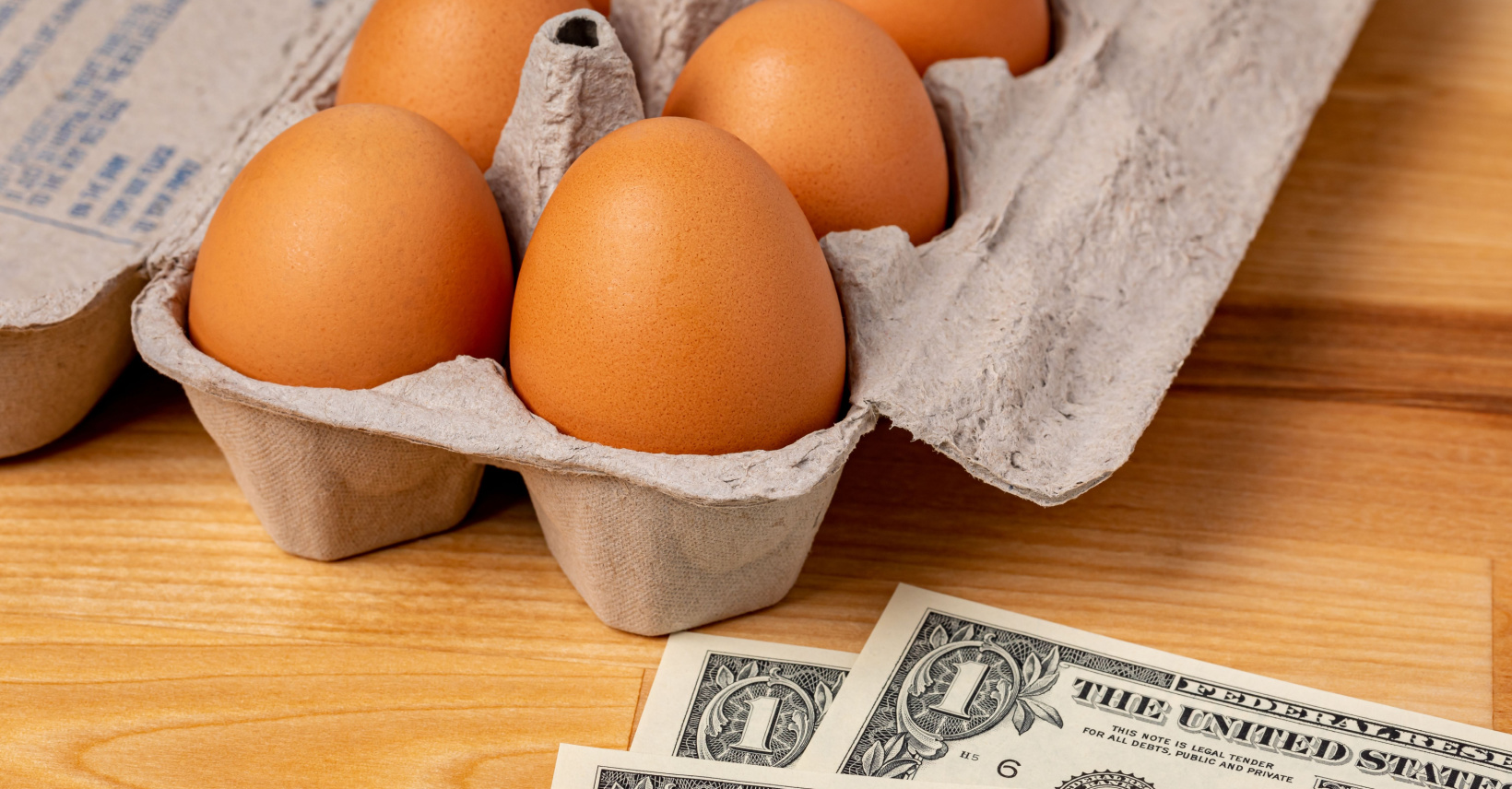Eggs are more expensive than ever, and everyone is talking about it. They have even given it a name: “eggflation”: According to statista.com, the retail price of a dozen eggs in 2021 was $1.79. The highest spike in the last 28 years was in 2015, when they rose to $2.75 per dozen. Today, the average price for 12 eggs in the US is six dollars. And they go for as high as $9.73 in Hawaii! So let’s examine why eggs are so expensive and what you can do about it.
Avian Flu
The start of the eggflation can be attributed to the Avian Flu. This highly pathogenic virus seriously constrained our egg supply. According to the U.S. Department of Agriculture, The Avian Flu killed almost 40 million egg-laying hens, lowering domestic egg supplies by 7.5% every month on average. This makes the Avian Flu the worst outbreak affecting chickens on record.
When a chicken gets infected, it must be removed, the facility sanitized, and new ones brought in. This process can take several months and is a significant reason for the egg production decline. Efforts to prevent infections in commercial and backyard flocks are ongoing. But now, the Avian Flu is quickly spreading to wild birds, making it impossible to contain. Unfortunately, we won’t see an end to the virus and its effect on egg production (and pricing) any time soon.
North Atlantic Oscillation
As if the Avian Flu was not enough, we got hit with the North Atlantic Oscillation. This weather phenomenon pushed El Nino off its tracks. As a result, we said goodbye to 2022 amidst severe cold in states that don’t usually get low temperatures. This included Florida, Texas, and Georgia. These three states are largely responsible for a good portion of our egg supply. In fact, eggs are one of Georgia’s two largest agricultural commodities.
When the temperatures get low, chickens stop laying. Stress and cold-related illness also contribute to their incapacity to lay eggs. Even after the North Atlantic Oscillation ended, the chickens were still massively affected. This put a significant damper on America’s already hurting egg supply.
Inflation
Inflation has affected everything, including eggs. Soaring inflation has increased farmers’ input costs, forcing them to raise egg prices in response. The higher cost of chicken feed, electricity, and packaging are just some of the many factors responsible. The fuel and transportation costs of eggs have also risen, as did the expenses of the market they are sold in. Employee wages and overhead have forced store owners and brands to raise their prices on food, eggs included. Eggflation occurs from farm to table.
Supply and Demand
Combined, the Avian Flu, North Atlantic Oscillation, and inflation have affected not only the price of eggs but the demand for them too. Typically when the cost of something soars, sales slow down, but not with staple items like eggs. We consumed about 288 eggs per person in 2022, according to Statista. This is an increase from the year before when prices were still normal.
When supply doesn’t meet demand, we have a shortage. And when we have shortages, we have price hikes. There is little competition with essential item shortages (like eggs). That’s because the profiteers know that people won’t stop buying the product. This is known as “price-gouging.” It’s unethical, and hopefully, our government can step in. Many U.S. Senators and organizations are asking the Federal Trade Commission to investigate this possible price gouging, but for now, the high prices aren’t budging.
What You Can Do About It
It doesn’t look like eggflation is going to end anytime soon. So what can we do about it? While we have no control over inflation, weather, or the avian Flu, there are two practical things we can do about the soaring costs of eggs.
The first solution is finding alternatives for cooking. For example, you may think your eggs are a must-have for baking and breakfast, but surprisingly good substitutes exist.
Egg Substitutions
Egg substitutes are commonly used for many reasons. These include allergies, vegan and vegetarian diets, and cutting back on cholesterol. This is good news when it comes to the soaring egg prices. It means plenty of known egg replacements work just as well in baking and other recipes. A commercial egg replacer works very well too. If you have ever eaten a hotel’s continental breakfast, you’ve probably had it. Here are some eggcellent substitutions:
Be aware that several ingredients—most notably baking powder and soda—offer the same lift to baked products as eggs. However, achieving the proper ratio is tricky. The best egg alternative for baked products is simply carbonated water.
You can also use Aquafaba. It’s handy in recipes that ask for egg whites (such as meringues or marshmallows). Aquafaba is the remaining liquid from boiling beans or legumes. It can be found in canned chickpeas or beans. The liquid has a highly similar viscosity to raw egg whites, making it an excellent egg replacement. Three tablespoons of aquafaba replace one egg.
Substitute =1 egg
| Water
Oil Baking powder |
1 1/2 tbsp
1 tsp 1 1/2 tsp |
| Mashed bananas | ¼ cup |
| Carbonated water | ¼ cup |
| Vinegar
Baking soda |
1 tbsp
1 tsp |
| Nut butter | 3 tbsp |
| Applesauce (unsweetened) | ¼ cup |
| Tofu (pureed) | ¼ cup |
| Yogurt (plain) | ¼ cup |
Raising Backyard Chickens
The second tip is a little more radical. However, if you need those eggs and have an outside area of any size, you can raise your own hens. Of course, raising backyard chickens isn’t an option for everyone. However, you would be surprised how easy and possible it is. You’ll need to check your city codes and lease agreements. But they are relatively easy to care for if you have a small outdoor area. There are entire books, magazines, and websites on raising backyard chickens, but here are the basics. You will probably see that you can certainly raise your own chickens and eat your own eggs.
You can easily buy a chicken coop (new or used) or make your own. It doesn’t have to be pretty. It just needs to keep your hens safe. A secure spot to sleep and “roost” and an area to eat and drink are all they need. If you don’t have a lot of open outdoor space for chickens to run, make sure to get a good-sized coop. In all fairness, though, even a smaller coop will be better than the conditions that most commercial chickens live in. If you want your chicken to lay all year round, install a heat lamp inside their coop. While they don’t need it for survival, hens stop laying when it gets cold (as they did during the North Atlantic Oscillation).
You don’t have to wait for spring to get chicks. Today, you can buy baby chickens online for as little as $2. Keep in mind that if you raise them from chicks, you will need a heat source until they are fully grown (16-24 weeks). You can also get adult laying hens locally. However, the demand right now is relatively high. As long as your hens are watered, fed, and warm, they will each lay an average of one egg per day. This can help you determine how many chickens to get.
Despite the rising costs, eggs are still a budget-friendly food to keep in your house. They are full of protein and still cheaper than meat. Whether you use egg substitutes, raise backyard chickens, or simply keep paying for store-bought eggs, it will be a while before we see an end to eggflation. The good news is that the USDA predicts a rise in production soon. However, by the time eggs are affordable again, you might just have your own.











